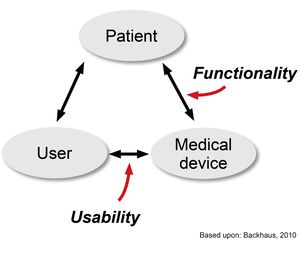KANBrief 3/17

Coinciding conveniently with publication of the new Medical Devices Regulation (EU) 2017/745, KAN has made a further tuition module available online (Author: Professor Claus Backhaus, FH Münster University of Applied Sciences, centre of ergonomics and medical technology). The Powerpoint slides cover the essential aspects to be considered for the ergonomic design of medical devices. Medical devices range from highly complex equipment such as ventilators, through blood pressure gauges and infusion pumps, to wheelchairs, clinical thermometers and dressings.
KAN has been providing ergonomics tuition modules for the training of engineers and designers free of charge for some years now. The new module adds the category of medical devices to the existing collection of modules. This product category necessitated a dedicated module, since medical devices have certain distinct properties not shared by other work equipment and the content of the other modules, with their focus upon machinery, cannot always be applied directly to medical devices. Lecturers and students, members of standards committees and OSH professionals now have access to information relating specifically to medical devices. The module can be completed in approximately 90 minutes.
All medical devices have two human interfaces: one between the user (e.g. the doctor or nurse) and the medical device, the other between the patient and the medical device. A number of particular aspects must be considered during the design of medical devices: they have a direct effect upon a patient's body, and are frequently used by diverse users and in diverse work systems. The opening slides of the new module explain essential terminology such as fitness for purpose, usability and functionality in comprehensible terms.
The module goes on to provide the user with an overview of legal requirements concerning the ergonomic design of medical devices, and of relevant standards governing them. The German Medical Devices Act (MPG) requires in turn that the essential requirements concerning medical devices as stated in the 93/42/EEC Medical Devices Directive be observed. As of November 2017, this directive will be replaced progressively by the Medical Devices Regulation (EU) 2017/745, which applies directly and unlike directives need not first be transposed into national law. The slides provide a brief summary of the legal situation with a comparison of the former and new requirements.
The slides in the second half of the module are devoted to the development process and its orientation to fitness for purpose, and describe a number of usability methods. These can be used in particular in the later phase of development to test and evaluate the usability of medical devices by means of prototypes or software simulations. Using the evaluation of an infusion pump as an example, the slides illustrate the procedure for a user test, step by step: from task analysis, through the definition of certain parameters (usability characteristics, value ranges and random sampling) to the test proper in the form of a laboratory experiment and interpretation of the test results.
The module is supplemented by an exercise showing how ergonomics is dependent upon the work situation at hand. Notes below the slides provide background information, facilitating access to the topic. Lecturers can order test questions if needed.
"Ergonomics of medical devices" tuition module. Registration is required for download.
Dr. Anja Vomberg
vomberg@kan.de
Learning targets. The students:
- are able to explain the concepts of fitness for purpose, usability and functionality of medical devices
- are familiar with the legal requirements concerning the ergonomic design of medical devices
- are able to name important standards governing the ergonomic design of medical devices
- are familiar with the impact of the ergonomic design of medical devices upon patient safety
- understand the importance of usability engineering for the development and design of medical devices and the work systems in which they are used
- are able to assess the suitability of different usability methods for evaluating the ergonomics of medical devices
- are able to devise a usability test